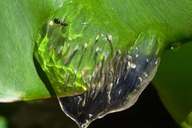|
Description
A small green arboreal frog; males 25 mm, females 22-28 mm. Greenish with violet markings and a violet dorsilateral band running from tip of snout to the middle of the flanks. Ventral surface is uniformly light. Skin smooth. Nostrils nearer to tip of snout than to eye. Tympanum poorly distinct, about 1/3 of eye size. Tibiotarsal articulation reaches the eye. Lateral metatarsalia connected. Webbing of fingers rudimentary, webbing of the foot 1(1), 2i(1.5), 2e(1), 3i(2.5), 3e(1), 4i(2.5), 4e(3), 5(1). Males with distinct femoral glands (6x2 mm).
Similar species: Other species of the subgenus Pandanusicola are differently coloured.
Distribution and Habitat
Country distribution from AmphibiaWeb's database: Madagascar
Ampamakiesiny Pass, An’Ala, Andasibe, Andranomay forest, Andringitra (Sahavatoy river), Ankafana, Ankeniheny, Anosibe, Besariaka near Moramanga, Betatao, Ivohibe, Marojejy, Midongy, Moramanga, Niagarakely, Ranomafana (Maharira forest, Ranomena).
It occurs between sea level and 1,400 m asl in pristine and disturbed rainforest and swamp forest. It is often found in the leaf axils of screw pines (Pandanus spp.) (Nussbaum and Raxworthy 2008).
Life History, Abundance, Activity, and Special Behaviors
Habits: Arboreal species, only found on Pandanus.
Call: Unknown.
Eggs and tadpoles: Eggs coloured turquoise with black. Tadpoles are very similar to those of Mantidactylus punctatus, but differ by their colouration with fine green punctuation. However, the possibility that they were the tadpoles of M. flavobrunneus, a species that occurred also in the same Pandanus where the tadpoles were found, can not be ruled out.
Tadpoles from Ankeniheny showed greenish-golden punctuations and a light short streak (max. 1 mm) at the tip of snout. Both colour features were already visible in small tadpoles. The eyes are situated dorsally. The tadpoles are smaller and less flattened than those of M. bicalcaratus. Tooth formula is 1/5+5//3.
Trends and Threats
It occurs in many protected areas (Nussbaum and Raxworthy 2008). Possible reasons for amphibian decline General habitat alteration and loss
Habitat modification from deforestation, or logging related activities
Intensified agriculture or grazing
Habitat fragmentation
Comments
Taken with permission from Glaw and Vences (2007).
References
Glaw, F., and Vences, M. (2007). Field Guide to the Amphibians and Reptiles of Madagascar. Third Edition. Vences and Glaw Verlag, Köln.
Nussbaum, R. and Raxworthy, C. (2008). Guibemantis pulcher. In: IUCN 2008. 2008 IUCN Red List of Threatened Species. www.iucnredlist.org. Downloaded on 01 April 2009.
Originally submitted by: Miguel Vences and Frank Glaw (first posted 2000-11-30)
Edited by: Kellie Whittaker (2011-12-15)Species Account Citation: AmphibiaWeb 2011 Guibemantis pulcher <https://amphibiaweb.org/species/4621> University of California, Berkeley, CA, USA. Accessed May 22, 2025.
Feedback or comments about this page.
Citation: AmphibiaWeb. 2025. <https://amphibiaweb.org> University of California, Berkeley, CA, USA. Accessed 22 May 2025.
AmphibiaWeb's policy on data use.
|





 Map of Life
Map of Life